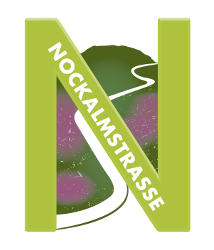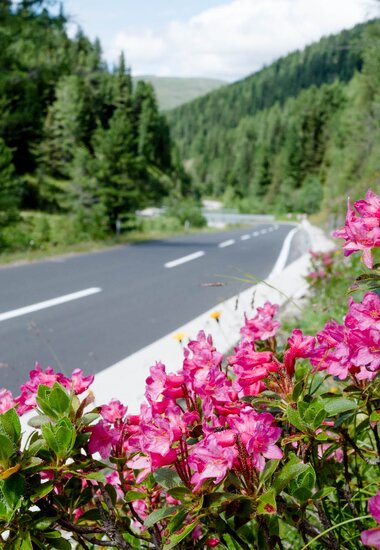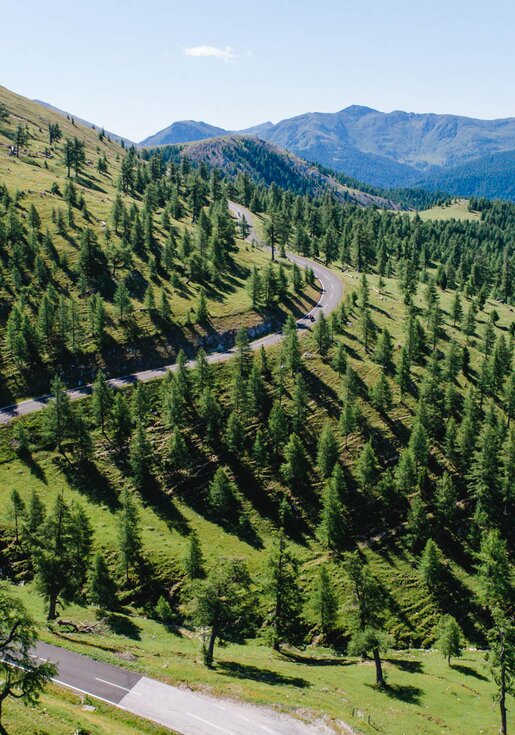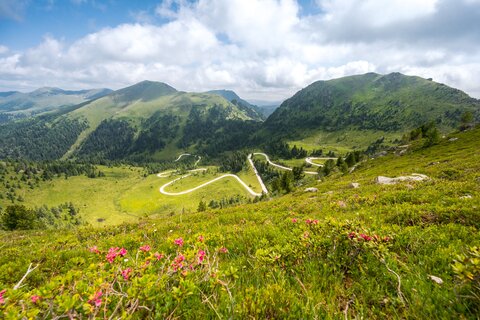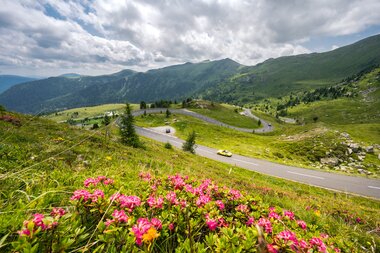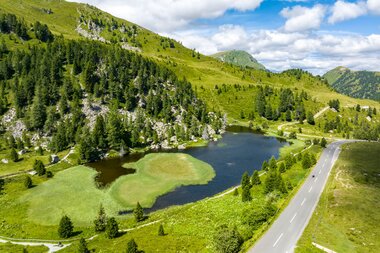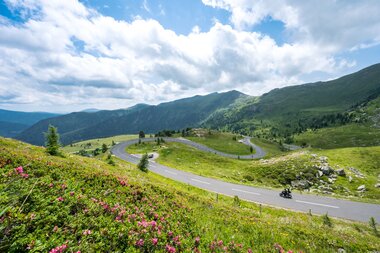Everything grows and flourishes on the "flower road"!
During a journey on the 34 km Nockalm Road you encounter the wonder of the Alpine natural surroundings as you drive by – vibrant mountain meadows with radiant flowers, lush green Alpine terrain which has an unbelievable variety of herbs and dense spruce, larch and Swiss pine woodlands. It is often only at a second glance that the Alpine animal and plant kingdom opens up its secrets, as the seasons change, they have developed survival strategies to cope with the abundance of snow in the mountains during the winter and to meet the challenges posed by an altitude location. On walks and hikes, which start right on the panorama road, you can discover these animal Alpine inhabitants, plants and other lovely natural features.
Did you know...
that the Nockberge has the biggest population of Swiss pine trees in the East Alps?
Swiss pine & larch:
masters of survival strategiesFor a long time the wood of the Swiss pine has been popular in the construction of living rooms and beds. These days we know that Swiss pine wood lowers heart rate and reduces blood pressure. So sleeping in a bed made of Swiss pine wood is like lying on a genuine fountain of youth! The cones from the Swiss pine are used in Carinthia to make a delicious liqueur. Less well-known is that the Swiss pine has developed a novel strategy to survive winter frosts down to minus 40 °C, by generating the anti-freeze glycol themselves! This means that the water reservoirs in their stem, which can hold up to 400 litres, have excellent protection. The larch has developed another survival strategy: it is the only native conifer to lose its needles in the autumn. It does this to prevent moisture loss in the winter.
Would you like to find out more about the survival strategies of the Swiss pine, larches & co.? Then take a look at our ‘Trees as Survivalists’ exhibition in the Grundalm!
Exhibitions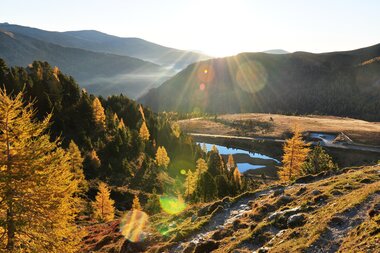
A firework display of colours: the woodlands on the Nockalm Road in autumm
As the days grow shorter and there are fewer hours of sunshine, this is a signal for larch trees to prepare themselves for the cold season. Their needles change colour and this wonderful gold, yellow hue lights up the treetops. And as the rays of autumn sunshine glide across the ‘Nocken’, the larches along the Nockalm Road descend into a veritable goldrush. A sensational sight!
Vegetation in the lofty heights - blossoming specialists in the mountains
The higher up you travel on the Nockalm Road, the shorter the vegetation period becomes. That is, the time which the plants need to grow to reach seed maturation. For every 100 metres ascent this time span decreases by a full week! So it is hardly any wonder that the kingdom of Alpine plants above the treeline has developed its very own survival strategies: strong roots which act as water reservoirs, below ground blossom roots and nodes, as well as hairs that protect them from drying out, are typical characteristics of mountain plants. Among these Alpine survival experts are the Arctic violet, house leek and the nigritella.
When you travel from the starting points on the Nockalm Road up to their highest point at 2042 metres altitude, you cross as many vegetation levels as if you had completed a 3000 kilometre journey from Carinthia to the Tundra on the North Cape.
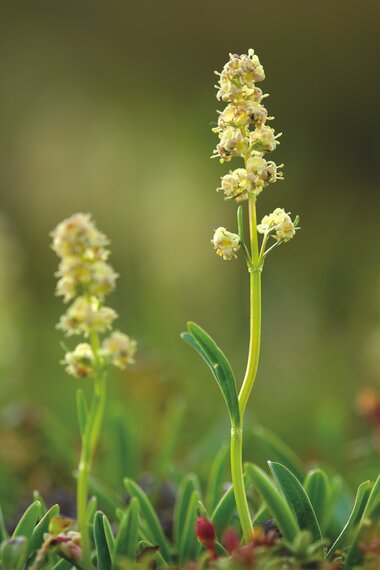
Spike lavender: a unique blossom in the Nockberge Biosphere Reserve
Among the variety of plants in the Nockberge there is one that is very special – one that was renowned even millennia ago and, as legend has it, even the great Egyptian queen Cleopatra used as a salve for her delicate skin: spike lavender! From July to September the herby aroma of this inconspicuous plant which grows between five and fifteen centimetres in height, is found across the meadows in the Nockberge. Yet it is not the flowers, but the roots that are what the few licensed spike lavender gatherers are looking for as they set about their careful and sustainable harvesting. In August they dig out the roots by hand. It is only at the Speick company in Frankfurt that these precious roots are turned into natural cosmetics.
Spike lavender, or Noric valerian – scientific name Valeriana celtica – is a healing plant that only grows in the Nockberge and in parts of the Lower Tauern, on non-calcareous soils from an altitude of 1800 metres. With its small, pale pink blossoms it is somewhat inconspicuous, yet its aroma is incomparable. To date it has not been able to be synthetically produced!
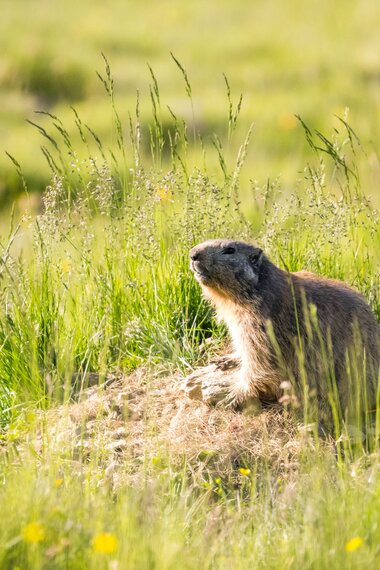
Marmots & other wild animals: snazzy whistling Nockberge inhabitants
If you hear a high-pitched whistle in the Nockberge, then you are very likely to be close to a marmot den, since these cute rodents communicate using high-pitched cries, which sound like whistles. If danger is imminent they whistle and quickly seek protection in their underground den. But the marmots are soon out and about on the expansive Alpine meadows again, to eat so they can build up their fat reserves for winter. In spring roots are on the menu, while in summer they will enjoy numerous herbs and grasses. This is when chances of seeing them running across a path in front of you are good, as you are out hiking through the gentle Nockberge. There are a wide range of other wild animals too of course. As well as the impressive red deer, nimble foxes, grazing chamois and elegant roe deer, there are delicate butterflies and chirping nutcrackers. With the first snow fall hibernation begins for the marmot family, lasting for around six months. And in the winter dainty snow hares and snow grouse leave their tracks in the glistening snow.
With a bit of luck while you are out on hikes along the Nockalm Road you will come across a wide range of animals roaming around. And this is a 100% sure thing if you pay a visit to the Pfandlhütte! In the ‘Wild Nocky Mountains’ exhibition you learn exciting information about the fauna in Carinthia’s Alpine area.
